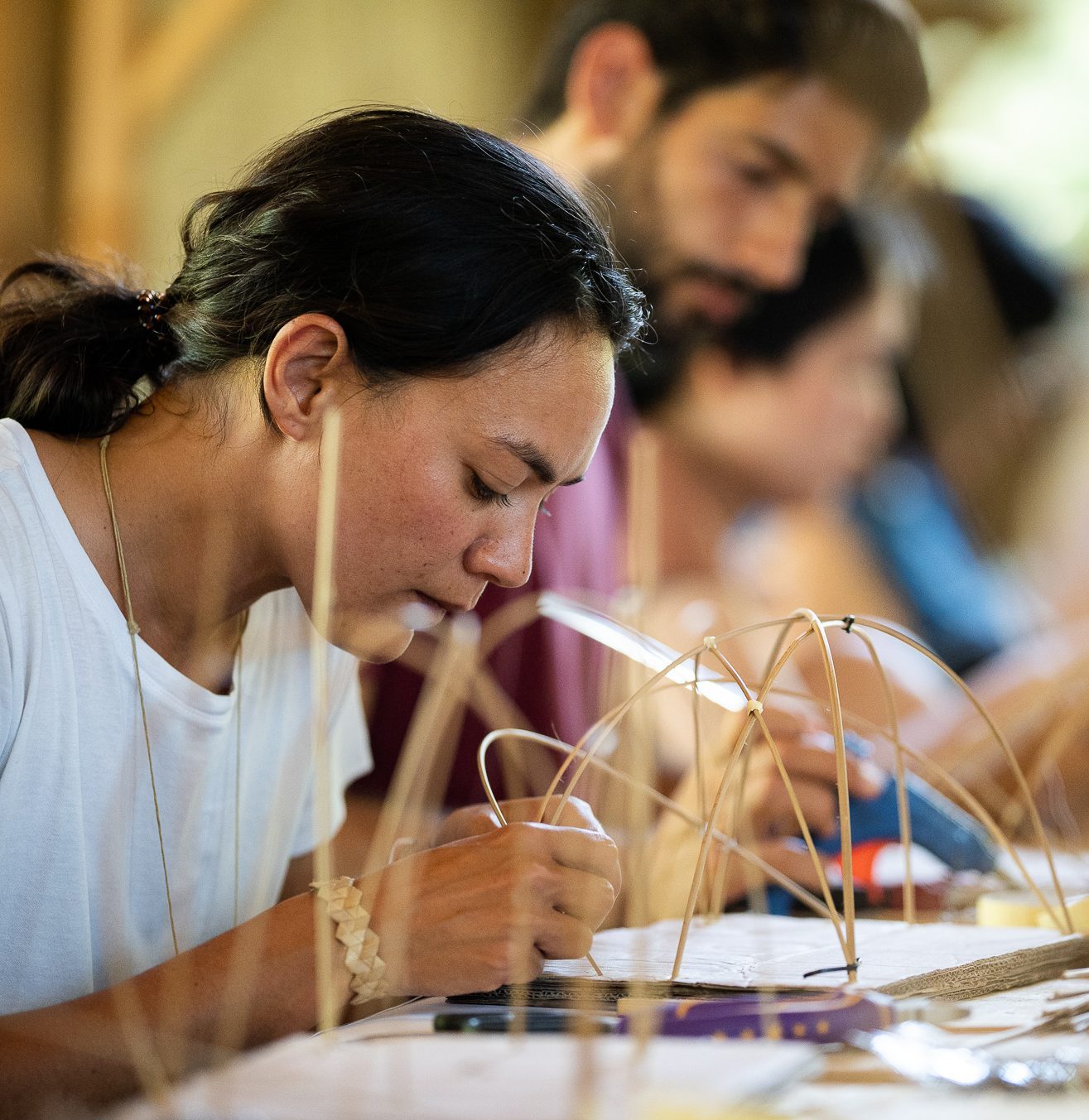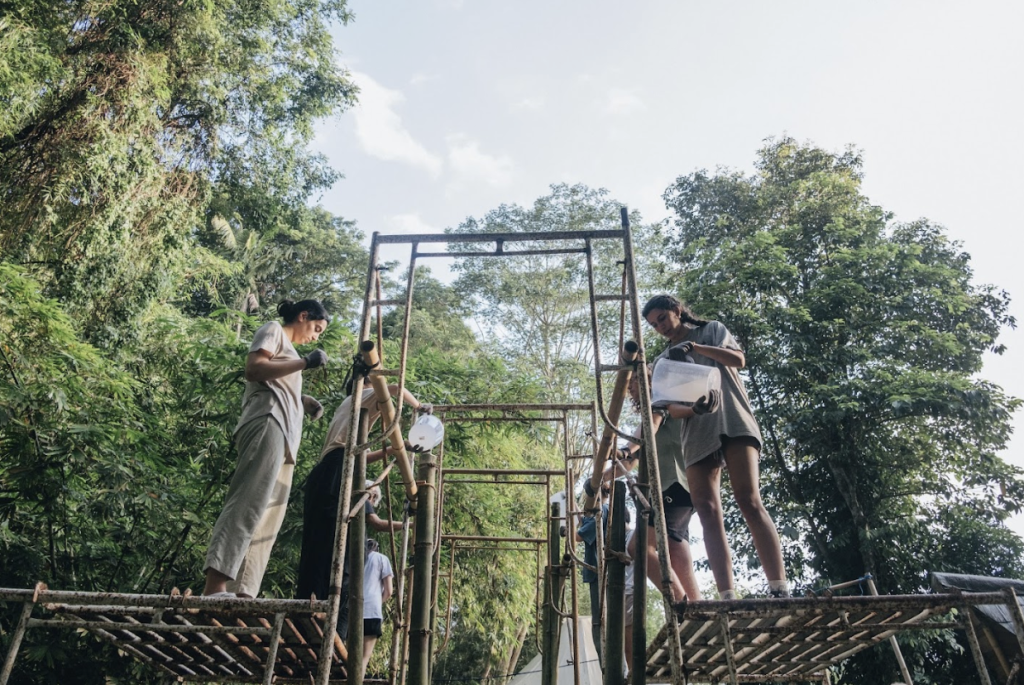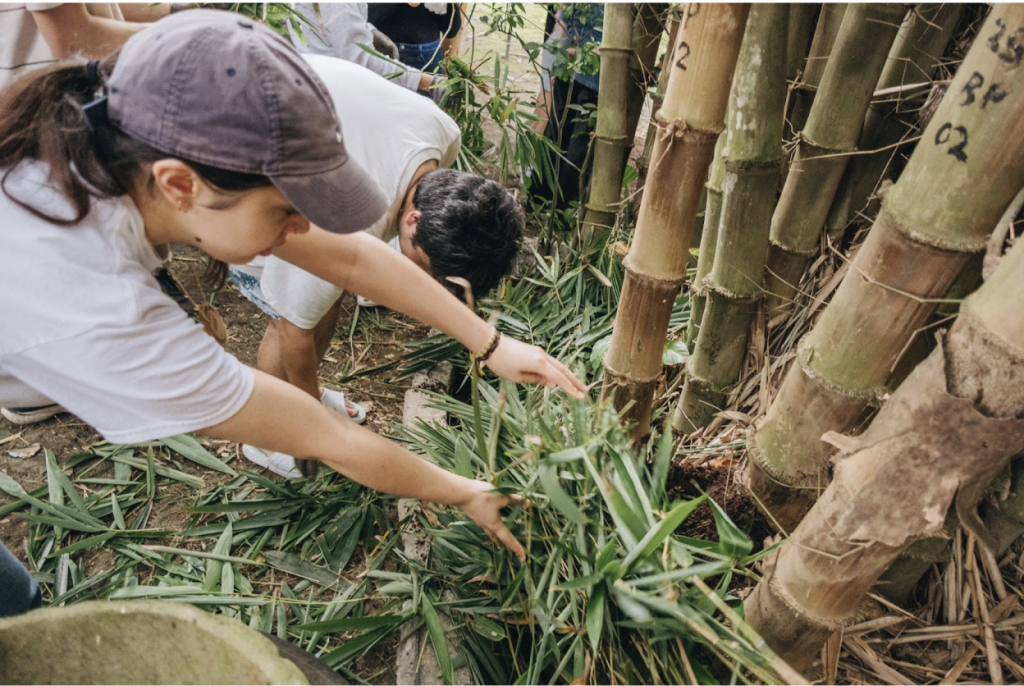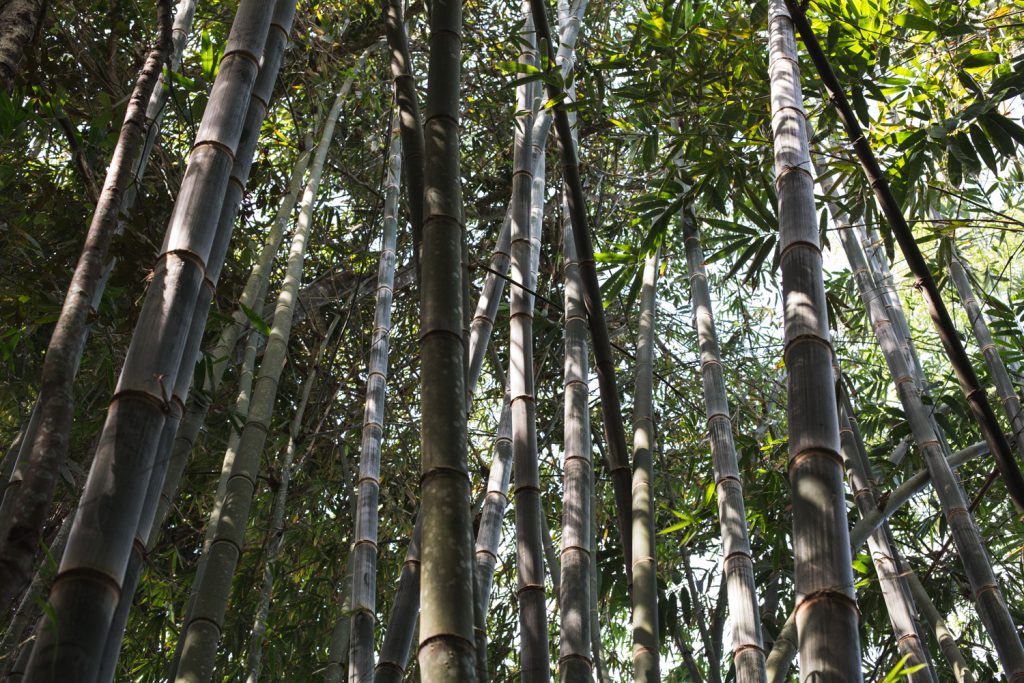Your Go-To Guide For Harvesting Bamboo Sustainably

Bamboo is one of the fastest-growing plants in the world. One bamboo plant consists of several poles that are referred to as a clump. Sustainable bamboo harvesting plays a crucial role in maintaining the long-term health, productivity, and quality of bamboo clumps and poles/culms.
Unlike other timber trees, bamboo is unique in that harvesting bamboo does not kill the ‘tree’ (in reality, bamboo is not a tree at all, it is a plant). By harvesting bamboo each year, the clump is strengthened and the quality of the yield is improved.
In this article, we outline the 5 most important things you must consider when harvesting bamboo.
5 Guidelines For Harvesting Bamboo Sustainably
- Harvest only mature bamboo poles.
- Cut the bamboo just above the first or second node.
- Mound new bamboo shoots with soil and compost.
- Remove problematic culms
- Treat your bamboo as soon as possible
These guidelines are important in creating regenerative bamboo forests, ensuring the long-term health of bamboo clumps, and producing viable poles that can be used for building with bamboo.
1. Harvest Only Mature Bamboo Poles
Plant a bamboo culm today, and in 1 year it will develop a rhizome system, these are its roots. The rhizome system will give birth to a new shoot every year. In one clump of bamboo you can find bamboo that is 0-1 years old (known as the new shoot), bamboo that is 1-2 years old (young culms), 2-3 years old (young culms), and above 3 years old (mature culms). A bamboo pole just takes 6-9 months to grow to its complete height but it takes 3-4 years more to get mature and ready for harvest. At these different stages of growth, bamboo contains different sugar levels and different properties of strength. Mature culms have stabilized sugar levels and enough strength needed for construction.
This is why when harvesting bamboo to use for building only mature poles must be harvested. Have a look at this image to see the different growth stages of a bamboo culm.

In summary, you must observe and identify the stage of the bamboo culm as the first step before harvesting. There are 4 main growth stages: shoot, young, mature, and old.
A common way to identify these stages is by noticing the color of the culm. A young culm is characterized by smooth, shiny green skin while mature culms have darker green skin with some other colors appearing, the nodes are greyish and you may be able to see the very first signs of white fungus (lichens) appear. As it grows older the foliage loses its green color and starts to turn grey. You will notice multiple generations of branches in mature bamboo and lichens cover most of the surface of the bamboo.
During the Bamboo U 11 day immersion, Arief Rabik of the Environmental Bamboo Foundation taught us to follow a coding system to ensure we harvest bamboo at the right time. In this coding system the clump number is denoted, the initials of the farmer responsible for the clump and the year of harvest. From the moment a shoot emerges, 4 years is added to establish the year of harvest. So if we were to see a shoot emerge this year in 2021, it would be ready for harvest in 2025. Then, on the culm, we would write a 25 to indicate the year of harvest.

In the picture above ‘03’ denotes the clump number in the forest, ‘KF’ denotes the farmer’s name to whom that clump belongs, and ‘19’ denotes the year of harvest.
2. Cut The Bamboo Just Above The First Or Second Node
When harvesting bamboo you will need a good saw, gloves, safety glasses and always be aware of your surroundings. When cutting a bamboo culm it is vital to cut just above the 1st or 2nd node from the ground. Cutting right above the node prevents the creation of a receptacle where rainwater can be collected and stagnated. This will attract insects and rot which will weaken the rhizome system inhibiting its ability to give birth to new culms.

In addition, don’t harvest your rhizomes, keep these to send up new shoots each year. Your rhizome system is essentially the body of your plant, it is the ‘trunk’ of the bamboo. Once your bamboo is cut, clear the leaves and branches and cut them to appropriate sizes to transport them safely.
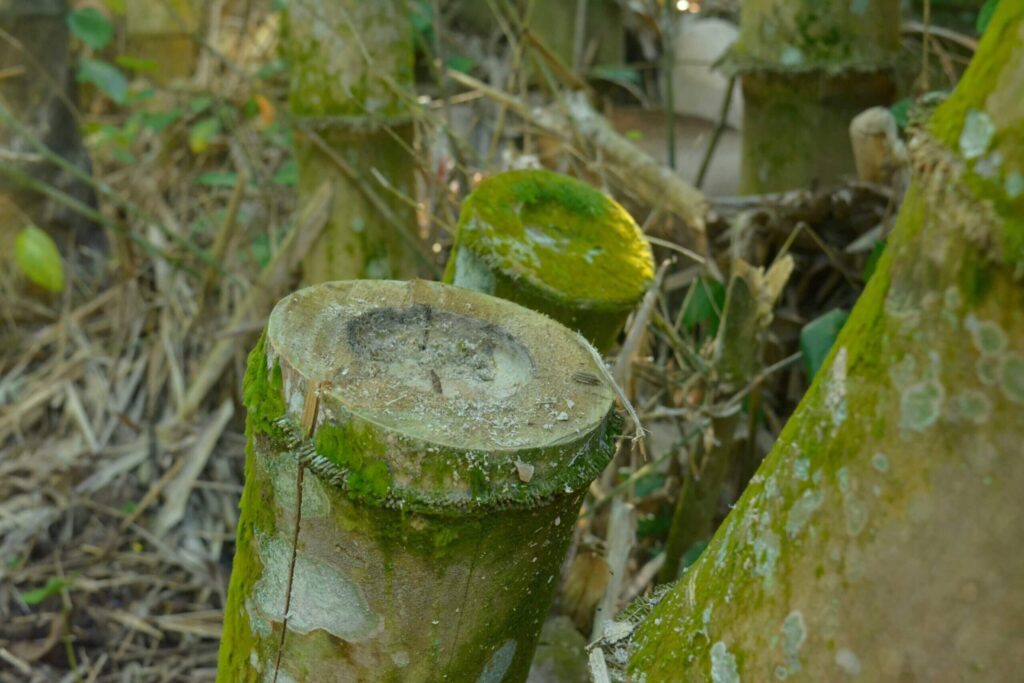
3. Mound New Shoots With Soil And Compost
When harvesting mature bamboo the clump loses a source of nutrient supply. Mounding soil around the new shoots and younger bamboo will replace these lost nutrients and help with creating strong, healthy poles.
The soil used for mounding is often dug from under the same clump’s canopy soil which contains a good amount of nutrients that the clump needs compared to the soil from a different place. Adding compost will also help speed up the growth and improve the health of your bamboo.
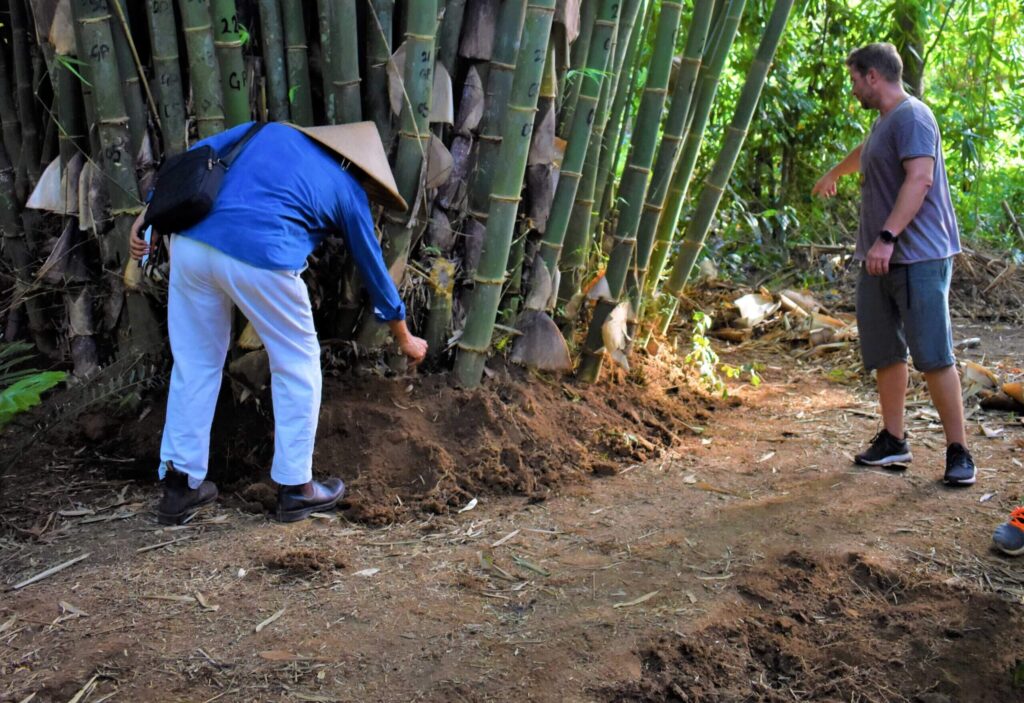
4. Remove Problematic Culms
It is important to keep your bamboo clump healthy by removing any problematic culms. Prune culms that are bent, stunted, broken, old, and diseased.
Keeping problematic culms that exhibit any of the aforenamed features will interrupt the growth of the clump, take up valuable space that could go towards growing healthier bamboo, and can cause the problem to spread. Needless to say, problematic culms should not be harvested for building.

5. Treat Your Bamboo As Soon As Possible
Treat your harvested bamboo as soon as possible, the preservability of the bamboo decreases with time after harvest. Avoid laying your bamboo on the ground directly as it will accumulate moisture and rot.
There are many forms of treatment, at Bamboo U we teach the Vertical Soak Diffusion method (VSD). If you want to learn more about the VSD method have a look at this step-by-step guide to treating bamboo using the vertical soak and diffusion method.

Once your bamboo is treated well and dried properly it is ready to be used for your bamboo construction.
Remember, by following this guide to harvesting bamboo sustainably you can improve the quality and productivity of your bamboo, which will contribute to the production of sustainable bamboo timber for generations.
Reference:
TOWARDS RESILIENT BAMBOO FORESTRY
A Reference Guide for Improved Management of Clumping Bamboo for Timber Bamboo by Arief Rabik and Ben Brown.

Maria is the Bamboo U Director and Sai Goutham is the Research & Development Manager. Together they formulate ideas, write content and create illustrations to share knowledge of bamboo architecture and design.
June 7-18, 2024
The 11 Day Bamboo Build & Design Course in Bali
In 11 days, we'll show you how to build bamboo structures we’ll share all that it takes to build with nature.
April 26, 2024
The Fundamentals of Building with Bamboo Online Course
All the fundamentals you need to get you started working with bamboo. Deep dive into cinematic videos and step-by-step guides that will provide you with a strong understanding of bamboo as a design and building material.










